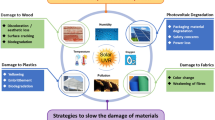Abstract
Scots pine (Pinus sylvestris L.)and chestnut (Castanea sativa Mill.) panels were coated with a polyurethane or an alkyd-based synthetic varnish. Some of the panels were impregnated with chromium-copper-boron (CCB) or the varnishes themselves before coating, as preservative-coating or water repellent (WR)-coating combination treatments, respectively. Earlier drastic changes in the intensity of the bands assigned to lignin and their shifts to some other stretching points were mostly attributed to chemical modification of lignin with the chromium in CCB, as well as the previously reported high color stability of CCB-impregnated wood. IR spectra of the nine months of weathering indicated that the synthetic varnish coating of non-impregnated or CCB-impregnated wood limited the reactions in lignin compared with polyurethane coating. Wood density and structural difference also seemed to play an important role since changes in lignin were mostly observed after six months of exposure for chestnut wood. Therefore, chemical reactions of CCB-wood cell wall components on the surface appeared likely to be affected from varnish type (their relative absorbency and distribution of sunlight), wood species (density and extractive substances), and exposure time and conditions.
Similar content being viewed by others
References
Stamm, A.J., “Effect of Dimensional Stabilization on Weathering Properties of Wood,”Amer. Paint J., 48, 72–88 (1963).
Ashton, H.E., “Clear Finishes for Exterior Wood, Field Exposure Tests,”Journal of Paint Technology,39, No. 507, 214 (1967).
Ashton, H.E., “Predicting Durability of Clear Finishes for Wood from Basic Properties,”Journal of Coatings Technology,52, No. 663, 63 (1980).
“NZFRI Research Directions,” New Zealand Forest Research Institute Ltd, No. 13, 1996.
Williams, R.S., Knaebe, M.T., and Feist, W.C.,Finishes for Exterior Wood: Selection, Application, and Maintenance, Publication No. 7291, Forest Products Society, Madison, WI, 1996.
Hicks, H.R. and Householder, D.F., “Trade Sales Paints,” inTechnology of Paints, Varnishes and Lacquers, Martens, C.R. (Ed.), Reinhold Book Corp., New York, 531–553, 1968.
Feist, W.C. and Williams, R.S., “Weathering Durability of Chromium-Treated Southern Pine,”Forest Prod. J., 41 (1), 8–14 (1991).
Bardage, S.L. and Bjurman, J., “Adhesion of Waterborne Paints to Wood,”Journal of Coatings Technology,70, No. 878, 39 (1998).
Evans, F.G., “Harmonization of Technical Requirements of Treated Wood in Europe. What Can We Learn from the Experience in the Nordic Countries?,” inThe Challenge-Safety and Environment, Proc. of Third Int. Wood Preservation Symposium, Feb. 6–7 1995, Cannes, Mandelieu, France, The Int. Res. Group on Wood Preservation, Doc. No. IRG/WP 95-50040, 2nd Edition, 276–282, 1995.
Suzuki, K., “Environmental Situations on Wood Preservation Industries in Japan,” inThe Challenge-Safety and Environment, Proc. of 3rd Int. Wood Preservation Symposium, February 6–7 1995, Cannes, Mandelieu, France, The Int. Res. Group on Wood Preservation, Doc. No. IRG/WP 95-50040, 2nd Edition, 283–294, 1995.
Harrow, K.M., “Leachability of Some Water-Soluble Wood Preservatives,”New Zealand J. Sci. Tech., Section B. 32 (6), 33–40 (1951).
Peylo, A. and Willeitner, H., “The Problem of Reducing the Leachability of Boron by Water Repellents,”Holzforschung, 49, 211–216 (1995).
Palmere, V. and Galyon, S., “Coating Performance over Borate-Treated Wood,”Proc. of First Int. Conf. on Wood Protection with Diffusible Preservatives, Hamel, M. (Ed.), Proceedings 47355, Forest Products Research Society, Madison, WI, 110–111, 1990.
Galyon, S. and Palmere, V., “Accelerated Weathering Performance of Various Coatings over Borate-Treated Wood,”Proc. of First Int. Conf. on Wood Protection with Diffusible Preservatives, Hamel, M. (Ed.), Proceedings 47355, Forest Products Research Society, Madison, WI, pp. 127, 1990.
Sell, J., Muster, W.J., and Wälchli, O., “Investigations on Weathered Wood Surfaces-Part V: The Efficiency of Cr-Cu-B-Salt-Solutions for Surface Treatment,”Holz als Roh- und Werkstoff, 32, 45–51 (1974).
Sell, J. and Feist, W.C., “Weathering Behavior of Chromium-Copper-Boron-Treated Wood,”Holz als Roh- und Werkstoff, 43 (12), 518 (1985).
Yalinkilic, M.K., Ilhan, R., Imamura, Y., Takahashi, M., Demirci, Z., Yalinkilic, A.C., and Peker, H., “Weathering Durability of CCB-Impregnated Wood for Clear Varnish Coatings,”J. Wood Sci., (in press).
ASTM D 358-55. Standard Specifications for Wood Panels to Be Used in Weathering Tests of Paints and Varnishes (Reapproved 1968), American Society for Testing and Materials, Philadelphia, PA, 1970.
Feist, W.C. and Hon, D.S.-S., “Chemistry of Weathering and Protection,” inThe Chemistry of Solid Wood, Rowell, R.M. (Ed.), Advances in Chemistry Series 207, American Chemical Society, 401–451 (1984).
Zavarin, E., Cool, L.G., and Jones, S.J., “Analysis of Solid Wood Surfaces by Internal Reflection Fourier Transform Infrared Spectroscopy (FTIR-IRS),”J. Wood Chem. Tech., 11 (1), 41–56 (1991).
Evans, P.D., Thay, P.D., and Schmalzl, K.J.,Natural Weathering of Wood in a Sunny Climate Effects on Surface Chemistry and Paint Adhesion, The Int. Res. Group on Wood Preservation, Doc. No. IRG/WP/97-201, 1997.
Faix, O., “Analysis of Solid Sample FTIR Spectra,” inMethods of Lignin Chemistry, Lin, S.Y. and Dence, C.W. (Eds.), Springer-Verlag Berlin Heidelberg, 50–71, 1992.
Harrington, K.J., Higgins, H.G., and Michell, A.J., “Infrared Spectra ofEucalyptus regnans F. Muell andPinus radiata D. Don.”,Holzforschung, 18, 108–113 (1964).
Faix, O. and Böttcher, J.H., “The Influence of Particle Size and Concentration in Transmission and Diffuse Reflectance Spectroscopy of Wood,”Holz als Roh- und Werkstoff, 50, 221–226 (1992).
Michell, A.J., “Second Derivative FTIR Spectra of Woods,” inCellulose and Wood: Chemistry and Technology, Schuerch, C. (Ed.),Proc. of the 10th Cellulose Conf., J. Wiley, New York, 995–1009 (1989).
Faix, O., and Beinhoff, O., “FTIR Spectra of Milled Wood Lignins and Polymer Models (DHP’s) with Enhanced Resolution Obtained by Deconvolution,”J. Wood Chem. Tech., 8 (4), 505–522 (1988).
Craciun, R. and Kamdem, P.D., “XPS and FTIR Applied to the Study of Waterborne Copper Naphthenate Wood Preservatives,”Holzforschung, 51 (3), 207–213 (1997).
Dawson, B. and Torr, K., “Spectroscopic and Colour Studies on Acetylated Radiata Pine Exposed to UV and Visible Light,” inChemical Modification of Lignocellulosics, compiled by Plackett, D.V. and Dunningham, E.A., fromProc. of Pacific Rim Bio-Based Symp., November 7–8, 1992, Roturua, NZ, FRI Bulletin 176, 41–51.
Sudiyani, Y., Takahashi, M., Imamura, Y., Minato, K., Tsujiyama, S., and Kajita, H., “Characteristics of Chemically Modified Wood Exposed to Weathering,”Proc. of Third Pacific Rim Bio-Based Composite Symp., December 2–5, 1996, Kyoto, Japan, 423–431.
Pandey, K.K. and Khali, D.P., “Accelerated Weathering of Wood Surfaces Modified by Chromium Trioxide,”Holzforschung, 52, 467–471 (1998).
Evans, P.D., Michell, A.J., and Schmaltz, K.J., “Studies of the Degradation and Protection of Wood Surfaces,”Wood Sci. Tech., 26, 151–163 (1992).
Park, B.S., Fruno, T., and Uehara, T., “Histochemical Changes of Wood Surfaces Irradiated with Ultraviolet Light,”Mokuzai Gakkaishi, 42 (1), 1–9 (1996).
Smith, C.D., “Infrared Spectroscopy,” inTreatise on Coatings, Vol. 2, Characterization of Coatings; Physical Techniques, Part 1, Myers, R.R. and Long, J.S. (Eds.), Marcel Dekkar, New York, 429–500, 1969.
“Meteorological Records for the Black Sea Region of Turkey,” Monthly Meteorology Observation Charts, National Indexes, Meteorological Affairs of State Ministry of Turkey, No. 17037, 1996.
Findlay, W.P.K.,The Preservation of Timber, Adam & Charles Black London, 1962.
Hunt, G.M. and Garratt, G.A.,Wood Preservation, McGraw-Hill Book Co., New York, 1967.
Nicholas, D.D. and Siau, J.F., “Factors Influencing the Treatability of Wood,” inWood Deterioration and Its Prevention by Preservative Treatments, Vol. II, Nicholas, D.D. (Ed.), Syracuse University Press, New York, 299–343, 1973.
Pandey, K.K., Chauhan, S.S., and Aggarwall, P.K., “Reaction of Wood with Inorganic Salts,”Holz als Roh- und Werkstoff, 56, 412–415 (1998).
Schmalzl, K.J., Forsyth, C.M., and Evans, P.D., “The Reaction of Guaiacol with Iron III and Chromium VI Compounds as a Model for Wood Surface Modification,”Wood Sci. Tech., 29, 307–319 (1995).
Pizzi, A. and Kubel, H., “The Chemistry and Kinetic Behavior of Cu-Cr-As/B Wood Preservatives Part 6. Fixation of CCB in Wood and Physical and Chemical Comparison of CCB and CCA,”Holzforschung und Holzverwertung, 34 (5), 80–86 (1982).
Korshak, V.V.,The Chemical Structure and Thermal Characteristics of Polymers, Translated by J. Schmorak from Russian, Israel Program for Scientific Translation Ltd., Jerusalem, Keter Press, Jerusalem, 1984.
Nussbaum, R.M., Sutcliffe, E.J., and Hellgren, A.-C., “Microautoradiographic Studies of the Penetration of Alkyd, Emulsion and Linseed Oil Coatings into Wood,”Journal of Coatings Technology,70, No. 878, 49 (1998).
Athawale, V.D. and Bhabhe, M.D., “Chemoenzymatic Synthesis and Characterization of Urethane Oils for Surface Coatings,”Journal of Coatings Technology,70, No. 879, 43–48 (1998).
Pouchert, C.J.,The Aldrich Library of Infrared Spectra.Edition III, Aldrich Chemical Co., Inc., Wisconsin, p. 1867, 1981.
Keller, R.J.,The Sigma Library of FTIR Spectra Edition I, Vol. I and II, Sigma Chemical Co., Inc., Missouri, p. 1347 and 1547, 1986.
Horn, B.E., Qui, J., Owen, N.L., and Feist, W.C., “FTIR Studies of Weathering Effects in Western Red Cedar and Southern Pine,” inChemical Modification of Lignocellulosics, Compiled by Plackett, D. V. and Dunningham, E.A., fromProc. of Pacific Rim Bio-Based Symp, November 7–8, 1992, Roturua, NZ, FTI Bulletin 176, 67–76.
Sell, J. and Feist, W.C., “Role of Density in the Erosion of Wood During Weathering,”Forest Prod. J., 36, p. 57 (1986).
Fengel, D. and Wegener, G.,Wood Chemistry, Ultrastructure, Reactions, Walter de Gruyter, Berlin, 1984.
Brown, H.P., Panshin, A.J., and Forsaith, C.C.,Textbook of Wood Technology, Vol. II, First Edition, McGraw-Hill Book Co., Inc., New York, 1952.
Dahlgren, S.-E and Hartford, W.H., “Kinetics and Mechanism of Fixation of Cu-Cr-As Wood Preservatives,”Holzforschung, 26 (62–69), 105–113, 142–149 (1972).
Dahlgren, S.-E., “Variability in Colour Intensity of C.C.A. Treated Wood,”J. Inst. Wood Sci., 6 (4), 28–30 (1973).
Author information
Authors and Affiliations
Corresponding author
Additional information
Technical Education Faculty, Mugla, 48000 Turkey.
Faculty of Forestry, Trabzon, 61080 Turkey.
Rights and permissions
About this article
Cite this article
Yalinkilic, M.K., Imamura, Y., Takahashi, M. et al. FTIR studies of the effects of outdoor exposure on varnish-coated wood pretreated with CCB or water repellents. Journal of Coatings Technology 71, 103–112 (1999). https://doi.org/10.1007/BF02697928
Issue Date:
DOI: https://doi.org/10.1007/BF02697928




